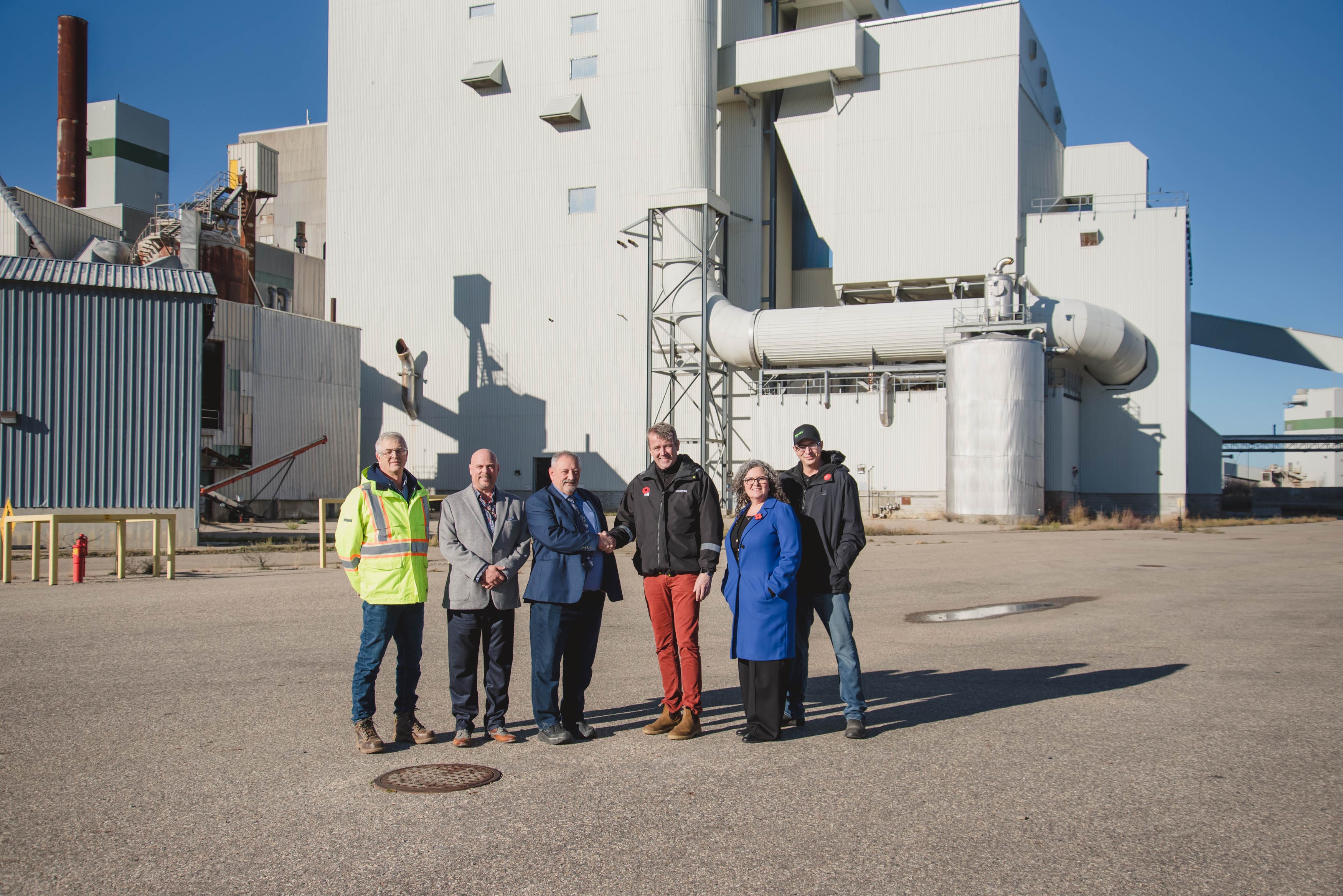BMI Group Acquires Former Prince Albert Pulp Mill to Drive Regional Renewal and Community Growth

Pictured from Left: Kelvin Winge: P.A. Mill Site Manager, Jason Collins: Corporate Development Officer, BMI, Bill Powalinsky: Mayor, P.A., Justus Veldman: Partner, BMI, Patty Hughes: CEO, P.A. Chamber of Commerce, Steve Neufeld: Manager, Bioveld North.
The BMI Group, one of Canada’s most active developers in the renewal of legacy industrial properties, has completed the acquisition of the former Prince Albert Pulp Mill, positioning it as a cornerstone for regional renewal that connects industrial readiness with community growth.
The acquisition, which closed on October 31, 2025, marks the first real opportunity in nearly two decades to retool the mill’s infrastructure for next-generation opportunities.
With a national record of turning dormant assets into regional catalysts, BMI Group has become one of Canada’s leading redevelopers of legacy industrial lands. Across the country, its projects are redefining how former mill and manufacturing sites can anchor new industries, attract investment, and strengthen the communities around them.
BMI’s work has already drawn more than $1 billion in tenant investment at its award-winning Bioveld Niagara campuses, where clean-tech and advanced manufacturing firms now operate alongside traditional industries. In Iroquois Falls, BMI has transformed a former paper mill into the Abitibi Connex Multi-Modal Hub, reconnecting the town to the ONR mainline and supporting major northern infrastructure projects. In Red Rock, BMI is pairing new housing construction with the conversion of another mill site into a mineral-processing and logistics hub.
Beyond industry, BMI has partnered with Marriott International to reimagine Stratford’s oldest hotel as The Queen’s Cue and led several heritage restoration projects that celebrate local history while supporting new economic opportunities. These initiatives reflect BMI’s distinctive approach—building regional partnerships that link industrial readiness with community renewal—a model now being brought to Prince Albert.
“I often say our work begins with listening,” said Paul Veldman, CEO of BMI Group. “But when we walked the streets of Prince Albert and met with Mayor Powalinsky, community members, and local business leaders, it was all about seeing; strong people, deep roots, and a community ready to grow. That combination is exciting for us.”
Located along the North Saskatchewan River, the 2,331-acre former Prince Albert Pulp Mill includes more than 900,000 square feet of industrial building space, direct rail access, and up to 130 megawatts of available power. Once a cornerstone of the regional economy, the site will be readied to support the next generation of industry and logistics, advancing Saskatchewan’s resource, energy and emerging bio-economies.
With its multimodal access and strategic position at the Heartbeat of the North, Prince Albert provides a strong foundation for new clusters in resource processing, logistics, and community infrastructure. Drawing on its integrated expertise across residential, hospitality, and industrial development, BMI will lead collaborative initiatives that connect the repurposing of the mill site with regional growth. The company’s approach recognizes that a strong industrial base depends on a strong community, where new housing, public spaces, and local amenities help attract and retain the workforce needed to grow Prince Albert.
“We’re really excited about this new partnership with the BMI Group. It speaks directly to our vision of Prince Albert as a healthy city of opportunities, one that supports diversity and innovation,” said Mayor Bill Powalinsky. “Repurposing the former pulp mill site is not just about revitalizing an underutilized property; it’s about strengthening our local economy, creating new opportunities, and positioning our community for long-term growth.”
BMI’s approach begins with community. At every site, the company works closely with local governments, First Nations, local residents, and regional partners, to shape a shared vision for renewal—one that reflects local values, honours history, and creates lasting social and economic benefit. This collaborative model has been key to BMI’s success in transforming legacy industrial lands into inclusive hubs for housing, industry, and innovation across Canada.
“Our community has sustained and been sustained by these lands for generations,” said Chief John Waditaka of the Wahpeton Dakota First Nation. “This site is part of that story. Together with BMI, we can put it to work in ways that bring lasting benefit to our people and opportunity for generations to come.”
“This marks the beginning of a partnership built on respect and shared purpose,” said Chief Kirby Constant of the James Smith Cree Nation. “By working alongside BMI, we can strengthen our communities and build something lasting together.”
“The Chamber looks forward to working with BMI to help attract a range of new end users to the site,” said Patty Hughes, CEO of the Prince Albert and District Chamber of Commerce. “A diversified mix of employers will not only strengthen Prince Albert’s economy but also create lasting opportunities for local businesses, trades, and workers. This kind of partnership between the private sector and the community is exactly what drives long-term resilience and growth.”
Together, these partnerships mark the beginning of a new chapter for Prince Albert, transforming a landmark property into a platform for shared prosperity and long-term growth.
-30-
For more information, contact:
Mayor Bill Powalinsky
306.953.4300
Contact Us
City of Prince Albert
1084 Central Avenue
Prince Albert, SK S6V 7P3
Phone: 306-953-4884
After Hours Emergency: 306-953-4348
Email Us




